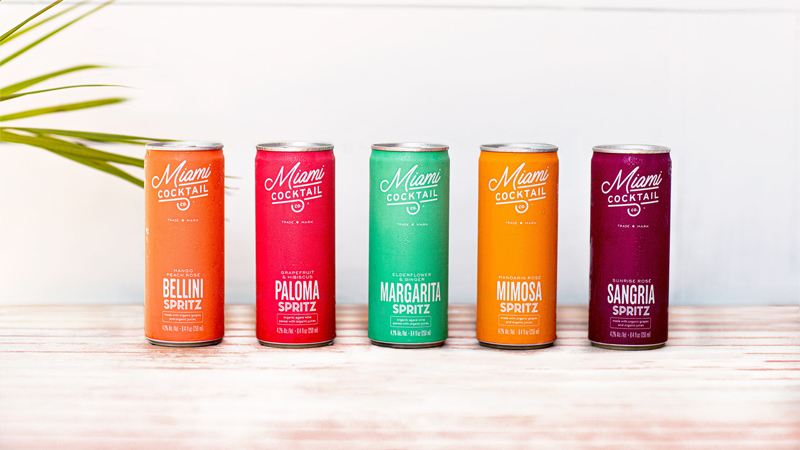There are few winners in a Covid-19-era beverage purchasing landscape, but ready-to-drink (RTD) cocktails are certainly coming out on top. Though demand was already growing for pre-mixed, canned, or bottled cocktails, the category exploded after the U.S. began to feel the pandemic’s effect, seeing 90.4 percent year-over-year growth in Nielsen-measured off-premise channels for the pandemic-impacted period ending June 27. Before Covid hit, year-over-year growth was just 21.5 percent for the 52-week period ending Feb. 29.
While many beverage categories have seen retail growth amidst the impact of Covid due to the cannibalization of sales from closed on-premise establishments, the majority of RTD cocktail sales have historically already come from off-premise. Even as states have begun to reopen restaurants and bars, RTD cocktails lead growth across all spirits categories, with Nielsen reporting 91.8 percent growth from May 31 to June 27. So if the growth of RTD cocktails isn’t driven by transfer from on-premise, what is prompting consumers to favor these drinks?
Due to a combination of factors — including the rise of at-home cocktail culture, convenience, concerns for health and safety, and the improved quality and variety of RTDs — consumers increasingly view prepackaged cocktails as the answer for today’s consumption needs and desires, ensuring that this beverage category isn’t going anywhere anytime soon.
Cocktails at Home, Without the Fuss
In the first few weeks after Covid forced statewide shutdowns and upended consumer purchasing habits, media outlets were quick to proclaim that alcohol sales were soaring as Americans drank more than ever. In reality, few beverage categories saw an increase in overall sales due to the near-obliteration of any on-premise dollars. Categories that were booming off-premise were lucky to achieve single-digit increases in overall sales.
However, RTD cocktails have largely been geared toward off-premise sales, with attractive packaging and portability making these canned or bottled products easy additions to retail shelves. “Off-premise has accounted for the vast majority of RTD sales,” says Ross Graham, the CEO of Miami Cocktail Company, which makes a number of organic, wine-based cocktails and spritzes.
While outdoor events and festivals had been strong outlets for RTD sales, most restaurants and bars crafted their cocktails in-house. But the shuttering of restaurants and bars across the country has indirectly affected the RTD cocktail category as a whole. As reflected in soaring sales of premium spirits, liqueurs, and mixers, the on-premise sector’s closure has prompted consumers to attempt to recreate their favorite restaurant cocktails at home.
“With the closure of bars and restaurants nationwide, consumers have naturally gravitated to at-home consumption,” says Graham. In the second quarter of 2020, Miami Cocktail Company’s online sales spiked, growing some 20 times over the same quarter last year.
Even though consumer demand for high-quality cocktails has prompted more people to turn to at-home bartending, RTD cocktails offer an easier, more accessible alternative — particularly for those who may not have much cocktailing experience or confidence. “At-home bartending is definitely on the rise, but there’s something to be said for bartender-quality cocktails without the added work,” Graham says. “RTD beverages, if executed well, bridge the gap between a premium experience and convenience, so they’re a preferred choice for many consumers.”
Eliminating the cocktail preparation process offers consumers ease and speed, but it also requires less financial and time investment. “The RTD format of cocktails allows us to get as close to [the bartender] experience as possible without having to source so many ingredients,” says Shawn Peterka, the experiential project manager for retailer Molly’s Spirits in Denver. Consumers need not buy an entire bottle of Campari (which produces its own bottled cocktail) to make a Negroni or make their own simple syrup for a Margarita or Old Fashioned.
With more time at home, consumers are also looking to go outside their comfort zones by trying new beverages, and RTD cocktails can facilitate that desire for exploration. “Canned cocktails are pretty easy to add to your cart,” says Nathan Arnone, the brand manager for Southern Tier Distilling in Lakewood, N.Y., which makes canned cocktails like the Gin and Tonic and Bourbon Smash. “It’s an indulgence but not a big risk.”
Consumers can try a new cocktail without worrying about potentially wasting a specialty liqueur or ingredient, which anyone who has a dusty, open bottle of hazelnut liqueur or flavored vodka in their cabinet can appreciate. “The cocktail-culture-come-home really gives consumers the opportunity to experiment without having to commit,” Peterka says.
Convenience and Quality
Consumers who weren’t traditionally cocktail drinkers may also be dipping a toe into the category through the approachability of RTDs. Arnone says he believes that the onset of Covid-19 has driven new consumers to the cocktail category in general.
“There’s something about drinking a cocktail that makes one feel civilized and I think that’s a particularly reassuring feeling during the time of a global pandemic,” he says. The company has seen a lot of crossover from beer drinkers looking for something new in a similar format and ABV range.
While convenience has always been a driver of interest in RTD cocktails, in a time where the simple act of going to the grocery store has become a tricky feat, consumers appreciate convenience now more than ever. “It’s just so convenient, and not just because we miss that on-premise experience,” says Peterka, adding that RTD cocktails offer a grab-and-go cocktail option at any moment. “Regardless of the application, the ability to simply reach for that perfectly mixed, already chilled can is refreshing.”
The pre-packaged format is also attractive for those who are looking to socialize while maintaining health and safety standards, such as minimizing contact and staying outdoors. “RTDs are mainly in a can format, so they are portable and single-serve,” says Brandy Rand, the COO of the Americas at the IWSR Drinks Market Analysis. “It’s perfect for social distancing and drinking: no touching of glassware or having to make a drink with ingredients other people are using.” Because many RTD cocktails are canned, these glass-free products are also good choices for outdoor gatherings.
Despite all these advantages offered by RTD cocktails, consumer demand likely wouldn’t be as strong if the category hadn’t seen a quality revolution in recent years. After all, the RTD cocktail category isn’t new; wine coolers, sangria, and malt-based beverages like Smirnoff Ice and Mike’s Hard Lemonade have been around for decades.
“RTDs have come a long way from what they once were,” says Graham. “Previously, most ready-to-serves were sugary, syrupy concoctions, canned Daiquiris, and hard lemonades loaded with artificial colors and sweeteners. That’s not the case anymore, as consumers have started to demand lower-calorie, lower-sugar options.”
Large and small brands alike are creating new and higher-quality RTD cocktail options. “There’s a changed consumer perception on the quality of RTD cocktails as more premium brands enter the market,” says Rand. “The format does not necessarily dictate the quality of the liquid inside.”
Rand adds that the industry has also gotten better at delivering excellent canned products. While big brands like Jack Daniels and Absolut have recently debuted canned cocktails, it’s been craft brewers and distillers or upstart businesses that have driven much of the premium RTD surge. Even individual bartenders and sommeliers are launching RTD products. “Now consumers have a range of better, more thoughtful, and more drinkable options, made mostly by craft distillers like us,” says Arnone.
New RTD cocktail options also resonate with consumer trends for healthier, low-ABV beverages. “In recent years, the industry has started to shift and we’re proud to be a part of the ‘better for you’ movement,” says Graham. “Brands are starting to pay attention to the call for ‘healthier’ options.” Many are low-alcohol, low-carb, gluten-free, and contain natural or organic ingredients.
The wider selection of RTD cocktails has also helped the category appeal to more consumers. “With each week, it seems, we are seeing more diverse offerings in the category,” says Peterka. While low-alcohol, low-calorie Vodka Sodas and Gin and Tonics have become popular, classic cocktails like Mai Tais and Bloody Marys and riffs like smoky Margaritas have also emerged onto the scene.
“There’s much more selection today, and the drinks are good,” says Kevin Fitzsimmons, the general manager of Dockside Brewery in Milford, Conn. “They’re totally consistent, and people love them.” The price point works well, too; the RTD selections at Dockside are between $8 and $10 depending on can size.
Poised to Support On-Premise Reopenings
While RTD cocktail sales did dip down to 75.1 percent growth for the week ending June 27, according to Nielsen, the category is poised to remain strong as the summer season sets in and consumers venture out. “With sheltering-in-place restrictions being lifted, consumers are outside much more and acting less formally in their purchasing and drinking habits,” says Peterka. “Grab-and-go solutions of convenience go hand in hand with summer.”
Even as restaurants and bars reopen to once again offer high-quality cocktails to guests, the category holds potential. “Even as restaurants reopen, we expect RTD cocktail sales to continue to grow,” says Graham. “With the category heading towards premiumization, we feel there is still a lot of opportunity to expand and reach new consumers.”
In fact, RTD cocktails have the potential to expand within the on-premise sector, particularly as restaurants and bars adapt to new restrictions and dining habits. “All indicators point to trends that suggest as the category expands socially, so, too, will it flourish in restaurants,” says Peterka.
Takeaway and delivery orders are expected to be important revenue drivers for restaurants for the foreseeable future, and in states where to-go alcohol sales continue to be legal, RTD cocktails can increase sales without requiring the investment of packaging portable cocktails in-house. “The to-go model is absolutely perfect for canned cocktails since, unlike plastic-lidded containers, they won’t spill or leak on the way home,” says Arnone.
The category also works well for restaurants and bars that are attempting to minimize or eliminate the use of reusable glassware and dinnerware due to health and safety precautions, or for venues that are forced to reduce labor costs. “As on-premise establishments operate at lower capacity and with less staff, they have to scale back food and drink offerings to make the most profit margin,” says Rand. “In some cases, RTD cocktails may offer the most viable option to deliver on experience while minimizing cost.”
Fitzsimmons has already noticed this benefit at Dockside, realizing that canned cocktails offer speed and efficiency with limited staff. “The labor required is cut in half,” he says. “It’s more than twice as fast. You’ll see two bartenders ring what four bartenders normally would.” Dockside has been selling 50 to 60 cases of RTD cocktails each week.
While RTD sales have not overtaken beer sales just yet, Fitzsimmons thinks that they will by next summer — an ironic future for a brewery business. Though Covid-19 may have prompted the RTD cocktail boom, the category’s success is poised to outlast even a pandemic.
This story is a part of VP Pro, our free platform and newsletter for drinks industry professionals, covering wine, beer, liquor, and beyond. Sign up for VP Pro now!

